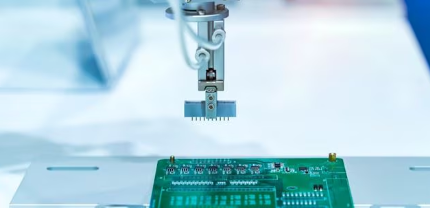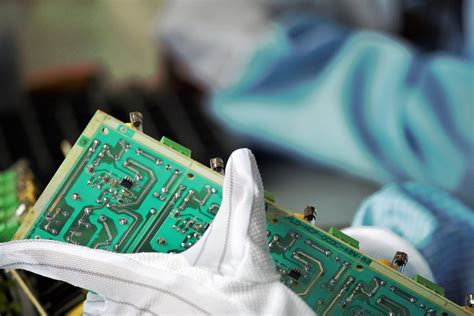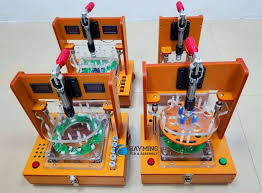PCB Accelerometers: Design, Applications, and Future Trends
Introduction to PCB Accelerometers
Printed Circuit Board (PCB) accelerometers represent a significant advancement in motion sensing technology, combining precision measurement capabilities with compact, cost-effective designs. These devices measure proper acceleration (g-force) by detecting changes in capacitance, piezoelectricity, or other physical properties when subjected to movement or vibration. Unlike traditional discrete accelerometers, PCB-based solutions integrate the sensing element directly onto the circuit board, offering numerous advantages in terms of size, performance, and system integration.
The development of PCB accelerometers has been driven by the growing demand for motion sensing across industries ranging from consumer electronics to industrial automation. Their ability to provide accurate, reliable acceleration data while maintaining small form factors and low power consumption has made them indispensable in modern technological applications. This article explores the fundamental principles, design considerations, implementation challenges, and diverse applications of PCB accelerometers, along with emerging trends shaping their future evolution.
Working Principles of PCB Accelerometers
Basic Operating Mechanisms
PCB accelerometers function based on Newton’s second law of motion, measuring the force required to accelerate a known mass. The most common implementations use one of three fundamental principles:
- Capacitive Sensing: These accelerometers contain a movable proof mass between fixed electrodes. Acceleration causes the mass to displace, changing the capacitance between electrodes. The capacitance variation is converted to a voltage output proportional to acceleration.
- Piezoelectric Sensing: Utilizing crystals that generate electric charge when mechanically stressed, these accelerometers measure the charge produced by a seismic mass under acceleration. They excel in high-frequency vibration measurements.
- Piezoresistive Sensing: These devices use strain gauges on a flexing element to detect acceleration-induced stress, with resistance changes indicating acceleration magnitude.
MEMS Technology Integration
Modern PCB accelerometers predominantly employ Micro-Electro-Mechanical Systems (MEMS) technology, where microscopic sensing elements are fabricated using semiconductor processes. MEMS accelerometers typically feature:
- A silicon proof mass suspended by flexible beams
- Interdigitated finger capacitors for displacement detection
- On-chip ASICs for signal conditioning
- Standard digital interfaces (I²C, SPI) for communication
The MEMS approach enables mass production of highly consistent, miniature accelerometers that can be directly mounted on PCBs alongside other electronic components.

Design Considerations for PCB Accelerometers
Key Performance Parameters
When designing or selecting a PCB accelerometer, engineers must consider several critical specifications:
- Measurement Range: Determines maximum detectable acceleration, typically expressed in ±g units (1g = 9.81 m/s²). Ranges vary from ±2g for subtle motion detection to ±500g for shock measurements.
- Sensitivity: Output signal per unit acceleration, usually in mV/g or LSB/g for analog and digital outputs respectively. Higher sensitivity improves resolution but may reduce dynamic range.
- Bandwidth/Frequency Response: The range of vibration frequencies the sensor can accurately measure, crucial for applications like structural health monitoring.
- Noise Density: Fundamental noise floor, expressed in μg/√Hz, affecting minimum detectable signal.
- Cross-Axis Sensitivity: Undesired response to orthogonal accelerations, ideally <1-2% of main axis sensitivity.
PCB Layout and Integration Challenges
Successful implementation of PCB accelerometers requires careful attention to board design:
- Mechanical Mounting: The sensor should be firmly attached to the measured structure, preferably near the center of mass for whole-body measurements. Improper mounting can introduce resonances that distort measurements.
- Signal Integrity: Analog outputs need proper grounding and shielding to prevent noise pickup. Digital interfaces require appropriate pull-up resistors and trace length management.
- Power Supply Decoupling: Clean power is essential, achieved through proper bypass capacitor placement (typically 0.1μF ceramic close to the device).
- Thermal Considerations: Temperature fluctuations affect accelerometer performance. Thermal isolation or compensation may be necessary in precision applications.
- Mechanical Stress Isolation: PCB flexure can induce spurious signals. Strategic placement away from board mounting points or stress-relief techniques may be required.
Applications of PCB Accelerometers
Consumer Electronics
PCB accelerometers have become ubiquitous in portable devices:
- Smartphones/Tablets: Enable screen rotation, step counting, gesture recognition, and fall detection.
- Wearables: Fitness trackers use accelerometers for activity monitoring and sleep pattern analysis.
- Gaming Controllers: Motion sensing for immersive gameplay experiences.
- Laptop HDD Protection: Detect free-fall to park heads and prevent damage.
Automotive Systems
Modern vehicles incorporate numerous accelerometers for safety and performance:
- Airbag Deployment: Crash detection systems use high-g accelerometers to trigger timely airbag inflation.
- Electronic Stability Control: Monitor vehicle dynamics to prevent skidding.
- Anti-Theft Systems: Detect unauthorized movement or towing attempts.
- Condition Monitoring: Predictive maintenance through vibration analysis of critical components.
Industrial and Infrastructure Applications
- Condition Monitoring: Predictive maintenance of rotating machinery by analyzing vibration signatures indicative of bearing wear, imbalance, or misalignment.
- Structural Health Monitoring: Arrays of accelerometers assess bridges, buildings, and pipelines for damage or excessive vibrations.
- Robotics: Provide feedback for motion control and balance in industrial robots and autonomous systems.
- Energy Harvesting: Convert ambient vibrations into electrical energy for powering wireless sensors.
Aerospace and Defense
- Inertial Navigation: Supplement or backup to GPS systems in aircraft and missiles.
- Flight Data Recorders: Monitor aircraft performance and assist in accident investigations.
- UAV Stabilization: Critical for flight control in drones and unmanned systems.
- Weapon Systems: Guidance and fuzing applications requiring high-g survivability.
Emerging Trends and Future Developments
Advanced Integration and Miniaturization
The ongoing miniaturization of MEMS technology continues to push PCB accelerometer capabilities:
- 3-Axis Single-Chip Solutions: Modern devices integrate three orthogonal sensing axes with digital interfaces in packages as small as 2×2×1 mm³.
- Sensor Fusion: Combining accelerometers with gyroscopes and magnetometers in “Inertial Measurement Units” (IMUs) enables more sophisticated motion tracking.
- Wafer-Level Packaging: New packaging techniques reduce size and cost while improving reliability.
Performance Enhancements
Research focuses on overcoming current limitations:
- Lower Noise Designs: Novel MEMS structures and readout ICs aim to achieve sub-μg resolution for precision applications.
- Higher Temperature Operation: Developments in materials and designs extend reliable operation beyond 125°C for automotive and industrial uses.
- Improved Shock Survivability: Designs resilient to >50,000g impacts benefit munitions and extreme environment applications.
Smart and Connected Accelerometers
The Internet of Things (IoT) revolution drives new capabilities:
- Edge Processing: On-device algorithms for activity recognition, anomaly detection, and data reduction.
- Wireless Sensor Nodes: Energy-efficient designs with integrated radios for structural monitoring and industrial IoT.
- Self-Testing Features: Built-in diagnostics verify sensor health in critical applications.
Novel Materials and Technologies
Emerging approaches may disrupt traditional MEMS accelerometers:
- Optical MEMS: Using photonic principles for potentially higher precision and EMI immunity.
- Graphene-Based Sensors: Exploiting graphene’s exceptional mechanical and electrical properties.
- Quantum Accelerometers: Early-stage research into quantum-mechanical motion sensing promises unprecedented accuracy.
Implementation Best Practices
Calibration and Compensation Techniques
Ensuring measurement accuracy requires:
- Factory Calibration: Most MEMS accelerometers undergo temperature and sensitivity calibration during production.
- In-System Calibration: User-performed procedures to null offsets and correct sensitivity, especially important for multi-axis alignment.
- Temperature Compensation: Software or hardware techniques to mitigate thermal effects on bias and sensitivity.
Data Processing Considerations
Effective utilization of accelerometer data involves:
- Filtering: Appropriate low-pass, high-pass, or band-pass filtering to extract relevant signal components.
- Sensor Fusion: Combining accelerometer data with other sensors (e.g., gyros) using algorithms like Kalman filters for improved orientation estimation.
- Feature Extraction: Time-domain (RMS, peak) and frequency-domain (FFT) analysis for condition monitoring applications.
Reliability and Testing
Ensuring long-term performance requires:
- Environmental Testing: Verification under expected temperature, humidity, and vibration conditions.
- Long-Term Stability Assessment: Monitoring parameter drift over extended periods.
- Failure Mode Analysis: Understanding potential failure mechanisms and their detection.

Conclusion
PCB accelerometers have evolved from specialized measurement tools to ubiquitous sensing elements that permeate nearly every aspect of modern technology. Their successful implementation requires careful consideration of mechanical, electrical, and application-specific factors to achieve optimal performance. As MEMS technology advances and new materials and processing techniques emerge, PCB accelerometers will continue to shrink in size while expanding in capability—enabling new applications in healthcare, robotics, infrastructure monitoring, and beyond. The future of motion sensing lies in smarter, more integrated solutions that combine precise physical measurement with sophisticated data processing, opening possibilities we are only beginning to explore. Engineers and designers who master the principles and practices of PCB accelerometer implementation will be well-positioned to innovate across this rapidly evolving technological landscape.





